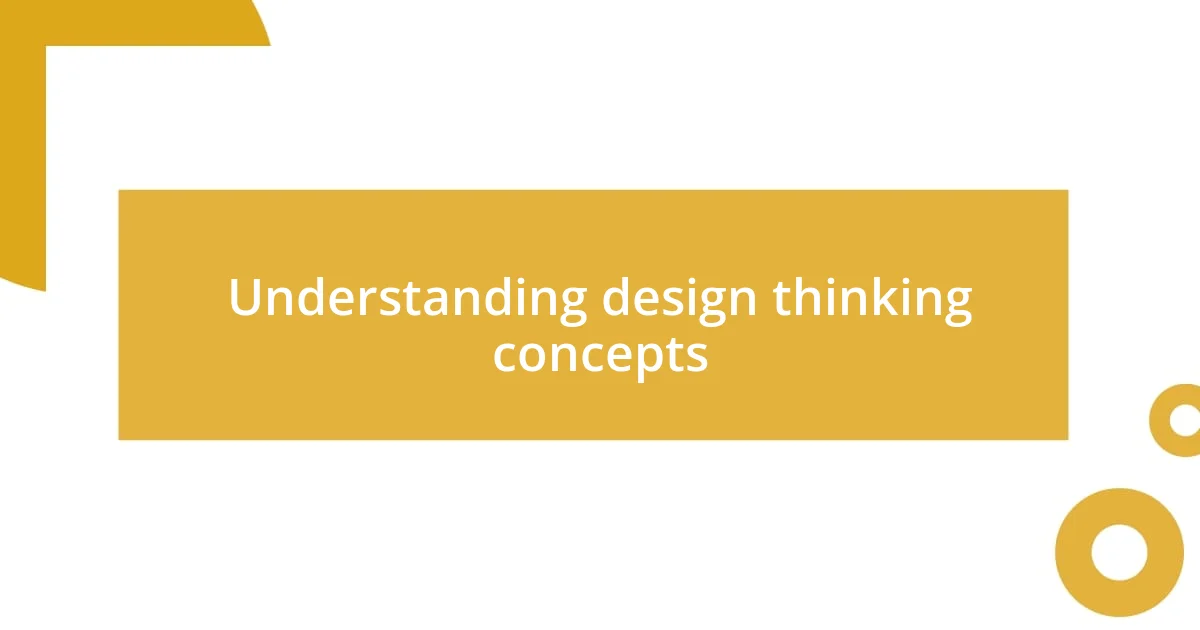Key takeaways:
- Empathy is crucial in design thinking; understanding users’ experiences can shift design perspectives and lead to more user-centric solutions.
- Collaboration with diverse, cross-functional teams fosters creativity and innovation, enhancing the design process.
- Managing ambiguity and securing stakeholder buy-in are significant challenges; success requires both resilience in iteration and effective communication of value through data and user feedback.

Understanding design thinking concepts
Design thinking is more than just a framework; it’s a mindset that encourages us to empathize with users, define problems, ideate solutions, prototype, and test. I remember feeling a mix of excitement and trepidation the first time I applied this methodology to a project. It was about creating a user-friendly app, and stepping into the shoes of my target audience truly opened my eyes to their needs and struggles.
One concept that resonated deeply with me is empathy. It’s fascinating how understanding another person’s experience can dramatically shift our perspective. I once spent an afternoon observing people interacting with a product similar to what I was developing. Those small moments of realization—like noticing how frustrated users got—made my design approach much more user-centric. Have you ever paused to truly listen to your audience? It’s a powerful experience that drives the whole design thinking process.
Prototyping was another aspect that I found particularly enlightening. Initially, the idea of producing multiple iterations felt overwhelming. However, when I started to embrace the concept of “fail fast to learn fast,” everything changed. I vividly recall the joy and relief when a prototype, which I thought might fail, turned out to be the most engaging in user testing. Isn’t it amazing how the process of creating something tangible can lead to unexpected insights? Through this iterative journey, I learned that flexibility and openness lead to breakthroughs that we might not foresee at the outset.

Key principles of design thinking
Design thinking rests on several key principles that guide the process. One such principle is a focus on human-centered design. In my experience, dedicating time to truly understand user needs has redefined how I approach projects. For instance, while working on a website redesign, I spent hours not just surveying users, but actually sitting with them as they navigated the site. Witnessing their frustrations and delight in real-time was enlightening.
Another core principle is the importance of collaboration. I recall a project where I collaborated with cross-functional teams. Our diverse backgrounds led to groundbreaking ideas that I would never have considered alone. Engaging in open brainstorming sessions created a space where creativity could thrive. Have you ever felt that spark of inspiration when ideas collide? It’s invigorating, and it’s this dynamic exchange that can lead to innovative solutions.
Lastly, the iterative nature of design thinking cannot be overstated. I remember a project where we revised our concepts repeatedly based on user feedback. Each iteration brought us closer to understanding what users truly valued. Experiencing the evolution of our design through continuous refinement was both challenging and rewarding. It made me appreciate that innovation often unfolds through patience and resilience.
| Key Principle | Description |
|---|---|
| Human-Centered Design | Focus on deeply understanding user needs and experiences. |
| Collaboration | Encourages teamwork and diverse viewpoints to inspire creativity. |
| Iterative Process | Emphasizes continuous testing and refinement based on feedback. |

Challenges faced in design thinking
One of the biggest challenges I faced in design thinking was managing the ambiguity that often accompanies the initial phases of a project. There’s a certain discomfort in not having all the answers upfront, isn’t there? I vividly remember a project where we had to pivot multiple times based on new insights, which left our team feeling a mix of confusion and frustration. It was a tough realization that clarity often emerges only after grappling with that uncertainty.
Another hurdle was getting buy-in from stakeholders who were accustomed to traditional approaches. I found myself in meetings where my proposals were met with skepticism, and it was disheartening. Convincing others of the value of testing and iterating meant I had to share real examples of success, building a narrative around data and user feedback. It felt like a tug-of-war between innovation and established norms—have you ever had to advocate so passionately for something you believe in?
Finally, closing the gap between ideation and execution proved to be a challenge I didn’t anticipate. Once we had brilliant ideas on the table, turning them into reality involved navigating technical constraints and resource limitations. In one instance, a fantastic concept ended up stalled due to budget restrictions, which left me grappling with disappointment. It made me reflect: How do we balance creativity with practical limitations? Finding that sweet spot is essential, yet frustrating at times and undoubtedly a part of the design thinking journey.















